Research Article 
 Creative Commons, CC-BY
Creative Commons, CC-BY
Effects of Training on Mechanical Properties of Achilles and Patellar Tendons of Older Adults: A Systematic Review
*Corresponding author: Janny Mírian Antonelli Tavares, Universidade Federal do Parana, Dept. of Physical Education, Coronel Francisco Heraclito dos Santos Avenue, Parana, Brazil.
Received:May 13, 2022; Published:June 08, 2022
DOI: 10.34297/AJBSR.2022.16.002243
Abstract
Purpose/Aim
Aging changes mechanical properties of tendons, influencing the transmission of strength, postural stability, and the risk of falling. Tendon stiffness can be modified by exercise intervention. Thus, this systematic review aimed to analyze the effects of different training programs on the triceps sural and quadriceps patellar tendons in older adults.
Materials and Methods
The search was performed in the databases Pubmed, Embase, Scopus, and Sport Discus. Studies analyzing:
a. Healthy older adults aged ≥ 60 years,
b. Submitted to exercise programs,
c. Primary or secondary outcomes of properties of patellar tendon or sural triceps tendon, and
d. In English were included.
Results
Ten of 1105 peer-reviewed articles were selected. The exercise programs included resistance training, isokinetic, walking, plyometric, vibrating platform, skiing, and varied duration, frequency, intensity, and progression. Significant changes were found in sural triceps tendon, patellar tendon stiffness, and Young’s Modulus after conventional high-intensity resistance training, Ski training, vibrating platform, and isokinetic training.
Conclusions
This review provides evidence that training programs, especially resistance training, can cause significant changes in stiffness and Young’s modulus of patellar tendon and sural triceps tendon in healthy older adults. High training loads seem to be necessary to promote tendon changes. The analysis also highlights the need for future studies investigating the influence of training variables
Keywords: Exercise; Achilles Tendon; Patellar Tendon; Tendon Adaptation; Tendon Properties; Aged.
Abbreviations: PT: Patellar Tendon; ST: Sural Triceps Tendon; RM: Maximum Repetition; OG: Older Group; VOG: Very Older Group; OCG: Older Control Group; VOCG: Very Older Control Group; HLG: High Load Group; MLG: Moderate Load Group; CG: Control Group; IG: Intervention Group; CRTG: Conventional Resistance Training Group; ITG: Isoinertial Training Group; LIG: Low Intensity Group; HIG: High Intensity Group; MG: Men Group; WG: Women Group.
Introduction
Tendons are structures responsible for transmitting forces exerted by the corresponding muscle to the bones [1]. The tendinous tissue is metabolically active and responsive to mechanical loading by changing its mechanical properties [2]. Such modifications make the tendons more compliant or rigid, which influences movement execution efficiency [3,4]. Aging causes a decrease in muscle strength [5] and influences tendon structures’ ability to sustain the same output when repetitive mechanical stresses are applied, such as those imposed during walking or running [6]. Therefore, older adults may become less efficient in executing movements and more vulnerable to injuries [7]. There is evidence that decreases in tendon stiffness affect the efficiency to store and return strain energy [8] which can impair dynamic postural stability by reducing the ability to produce force rapidly and increase the risk of falling [9]. On the other hand, systematic exercises can modify tendons’ mechanical properties [10,11], increasing stiffness. Some studies point to high-intensity training as a determinant in increasing tendon stiffness [12,13], but the results from other studies are still conflicting, primarily due to the different stimuli applied. For instance, plyometric training, concentric contractions, and static stretching showed little or no effect on the tendons’ properties [14,15]. However, interventions with different stimulus and intensities that include isometric, eccentric contractions, ballistic stretches have increased the stiffness of the sural triceps (ST) tendon. Other studies have indicated that resistance training enhances stiffness and Young’s modulus of the quadriceps patellar tendon (PT) [16]. Therefore, it seems that adaptive responses are highly dependent on the type of stimulus applied.
Some studies point to the effectiveness of resistance training in older adults in which concentric and eccentric contraction culminate in improvements in muscle function and increases in tendon stiffness [17]. Such modifications can be beneficial for gait stability in older adults [7]. In fact, stronger older adults have shown greater tendon stiffness (33%) when compared with weaker ones [18], which can result in better stability due to the characteristics of the patellar tendons and sural triceps [19]. Functionally, the ability to respond promptly to unexpected situations is relevant, as it can improve the ability to regain balance [20].
Thus, it is essential to understand the effects of exercise programs on tendons’ properties in older adults. It is not clear whether the changes in the tendon’s mechanical properties result from the aging processes, whether they are related to physical activity reduction or whether they result from the combination of these factors. Although the declines in the tendon’s properties have been related to age, it is not clear whether the mechanical loads applied during physical activities can minimize or even reverse these changes [18]. Therefore, this study aimed to describe and compare the literature’s findings regarding the influence of different types of training programs on the mechanical properties of the triceps sural and quadriceps tendons in older adults
Materials and Methods
This systematic review was carried out following PRISMA (Preferred Reporting Items for Systematic Reviews and Metaanalyses) statement.
Search Strategy
The studies’ identification was carried out on digital database platforms such as Pubmed, Embase, Scopus, and Sport Discus, in August 2020 (updated in February 2021), without filter strategies and time restrictions for the year of Publication. The selected descriptors were tendon properties, tendon stiffness, tendon mechanical, muscle-tendon, aged, elderly, and older adults, were combined with the Boolean operators “AND” and “OR” and adapted for each database as needed. Two independent reviewers performed the search, applied the inclusion and exclusion criteria, and included the selected articles for analysis. In the case of disagreement, a third reviewer was consulted.
Inclusion and Exclusion Criteria
Studies meeting the following inclusion criteria were
considered for the review:
i. Healthy individuals aged ≥60 years (mean age)
ii. Exercise programs with details of the intervention
iii. Measured properties of patellar or sural triceps tendon as
primary or secondary outcomes (such as tendon stiffness and
Young’s modulus)
iv. Published in English
v. Publications adopting a peer-review process.
On the other hand, the exclusion criteria were:
i. Abstracts of congresses, reviews, monographs, theses,
dissertations, and studies performed with animals
ii. language other than English
iii. Participants with cardiovascular, neurological, musculoskeletal
disorders and functional limitations
iv. Studies with dietary and hormonal interventions associated
with the exercise program.
Analysis of the Methodological Quality of The Studies
The selected studies’ methodological quality was carried out using the Pedro scale, composed of 11 questions that generate a maximum score of 11 points. However, items 5 and 6 - referring to the blinding of the participants and therapists and the intervention - were not applied due to the selected studies’ characteristics. Thus, the maximum score was 9 points. The higher the score, the better the quality of the research. The quality analysis was carried out independently by two authors, and the differences were discussed and resolved by consensus meetings.
Data Extraction
A data extraction sheet was developed in Microsoft Excel, and data extraction was performed by one author and reviewed by another. Data from all eligible trials were extracted for the following variables: name of authors, year of publication, number of participants in the intervention and control group, gender, age, details of interventions (intensity, types of exercises, volume, duration of the program and frequency) and the primary and secondary outcomes related to the properties of the tendon.
Results
The search performed in the four electronic databases resulted in 2216 hits, and follow the exclusion of duplicates, 1105 studies were identified. After screening by title and abstract, 18 potentially eligible studies were selected. A full-text assessment of these articles was carried out, which led to the exclusion of 8 studies. Thus, 10 studies met the selection criteria and were included in the present study. [Figure A] shows the study selection flow chart.
Methodological Quality
The selected studies’ quality ranged from 6 to 9 points, with 7 being the most frequent score, which indicates good quality. The maximum score (9 points) was reached by 2 of the 10 articles evaluated (Table A).
Characteristics Of the Studies
The total number of participants involved in the studies was 295 older adults (94 in the control groups and 201 in the intervention groups). Only seven studies had a control group, while three had different intervention groups. Eight studies involved participants of both sexes; one was carried out with men and one with women. The age of the participants ranged between 57 and 91 years. (Table B) displays the characteristics of the 10 included studies.
Characteristics Of Interventions
Among the selected studies, six trials were conducted with resistance training, and the others used plyometric training (e.g., hopping), training on a vibrating platform, Ski training, and walking program. The training program duration ranged from 8 to 52 weeks, with 12 weeks being the most recurrent. The walk study lasted 24 weeks and the plyometric study 11 weeks. The study by Reeves and collaborators lasted 14 weeks [16]. The sessions frequency was 3 times a week; however, Han and collaborators did not report this variable [11]. Among the studies that used resistance training, three presented a control group [2,16,21] and two had more than one intervention group [2,21] These studies investigated the tendon adaptation of older adults of different age groups in training [2], the effect of training intensity [21] and strength training on the mechanical properties of the tendon [16]. Another three studies had no control group and analyzed the effect of conventional training versus is inertial training [17], tendon adaptation in older adults of both gender [22] and, investigated the effect of training intensity on tendon parameters [9].
Outcomes
For studies to be included in the review, measurements of stiffness or Young’s modulus of the patellar or sural triceps tendon were required as a primary or secondary outcome. In the selected studies, all used ultrasound techniques to determine the tendons’ properties. Seven studies investigated the effect of different exercise programs on the patellar tendon’s mechanical properties, all of which evaluated stiffness and five measured Young’s modulus. On the other hand, four articles analyzed the adaptation of the sural triceps tendon induced by exercise, in which only stiffness was measured.
Effects Of Exercise Programs
Among the studies that evaluated the patellar tendon’s stiffness, approximately 60% (n=4) showed significant increases after the intervention, while the others remained at baseline. Grosset, et al. [9]. investigated the effect of resistance training intensity on stiffness and observed an increase of 57.7% only in the high-intensity group after 12 weeks of intervention [9]. Reeves and colleagues found an increase of 65% in the patellar tendon’s stiffness after 14 weeks of strength training [16]. In the study by Onambele-Pearson and Pearson, which compared the tendon adaptation among older adults of the opposite sex after resistance training, both groups showed a significant increase in patellar tendon stiffness of 80% and 13% for older men and women, respectively [22]. Finally, Seynnes and collaborators analyzed the effect of ski training on older adults, observed increases of 14% after the intervention [23].
The Young’s modulus of the patellar tendon was analyzed in five studies, of which three showed significant change. Although the Young’s modulus of the patellar tendon remained at baseline in two studies [2,21], the control group showed a tendency to decrease Young’s modulus. Reeves and collaborators showed a 69% increase after strength training [16], while Onambele-Pearson and Pearson observed a rise of 70% and 15% in older men and women, respectively, after 12 weeks of resistance training [22]. Finally, Seynnes and colleagues found gains of 12% in Young’s modulus of the patellar tendon in the group that performed ski training [23].
The stiffness of the sural triceps tendon was measured in four studies, but only two showed significant changes. Kubo [15] and Hoffren-Mikkola [6] did not observe changes in the sural triceps tendon stiffness after a walking and plyometric training program, respectively. Nonetheless, Han and collaborators reported gains of 20% in tendon stiffness in older women after training on a vibrating platform [11]. Finally, Onambele and colleagues found increases in the stiffness of the sural triceps tendon by 54% in the group that performed conventional resistance training and 136% in the group that completed is inertial training [17].
Discussion
The present systematic review indicates the different exercise modalities applied so far in the elderly and their influence on the properties of the patellar tendons and the sural triceps, such as stiffness and Young’s modulus. It shows in detail the periodization and the effects of each type of training and the level of significance of the changes in the properties of the tendons. From the analysis is possible to observe gaps in knowledge regarding changes in the tendon properties of older adults. What is the stimulus threshold for adaptations to occur in the tendon? Since high loads can be determinant in the adaptive responses of tendons, what would be the duration, repetitions, series, and weekly frequency of application of this load in the training of the elderly? After how long of training is there a stagnation in the effects of exercise? How long of detraining is necessary to observe reduction in tendon stiffness in the elderly population after intervention? In addition, the scarcity of studies investigating eccentric stimuli in the mechanical properties of tendons in elderly is also noteworthy.
These notes differ from the review by McCrum [24] who analyzes the effects of aging on the properties of tendons, with a brief suggestion on the load and training time needed to neutralize age-related changes in the properties of tendons in the elderly. In addition, we carried out a systematic review following the PRISMA procedures, describing the search strategy and the selection process of the articles, listing all data extracted from each article, analyzing the quality of the studies, and summarizing the results. Another point to highlight is the inclusion of 6 different articles from McCrum’s review [24]. This difference is possibly due to searching methods and the updating of recently published articles. Thus, the present review brings new evidence and perspectives on the effect of different types of exercises on the properties of the tendon in the elderly and notes of gaps for future investigations.
Ten selected studies demonstrated the use of six intervention modalities to promote tendon adaptations in older adults, which measured stiffness and Young’s modulus. The overall effect of interventions designed to improve stiffness was significant in seven studies (70%) and three for Young’s modulus (60%). Among six studies that applied resistance training, only Onambele and collaborators [17] evaluated the stiffness of the sural triceps tendon. The other studies investigated only the stiffness of the patellar tendon of the quadriceps. The small number of studies express the lack of investigation in this field. Such studies are relevant since stiffness influences postural control and static balance [19] and the risk of falls [25]. Reductions in stiffness have potentially detrimental effects on strength and power production, especially during the propulsion phase during the walk (pushoff) [26]. Besides, there is evidence that the reaction time can be compromised in more compliant tendons, which can delay the response time and, consequently, increase the risk of falls. However, more robust experimental evidence is still needed to support such assumptions.
The current search did not include studies that involved training with eccentric stimuli in older adults. Seynnes and colleagues used ski training, which demands a significant number of eccentric contractions. However, the stimuli applied in this study did not produce significant changes in stiffness (14%) when compared to other types of training [23]. Studies involving high-intensity eccentric training in healthy adults have shown significant increases of 88% in tendon stiffness [13], surpassing the positive results of other findings that used eccentric contractions at submaximal levels [27,28], such as the 31% increase in Achilles tendon stiffness presented by Kay and collaborators [29]. Malliaras and colleagues investigated the effect of intensity and type of contraction (concentric versus eccentric) on the Patellar tendon properties. They observed that eccentric training associated with high loads presents better adaptive responses of the tendon compared to the concentric group [30]. Hypothetically, if the mechanical stress or the magnitude of the load were the main factors for the adaptation of the tendon, eccentric stimuli could be attractive to older adults. It is known that eccentric stimulus produces higher levels of tension and less metabolic demand than conventional training [4]. Thus, studies that analyze responses to eccentric stimuli in older adults are required.
The heterogeneity of stiffness adaptations and Young’s modulus between the studies can be explained by using different training protocols. There is a wide variation in duration, intensity, volume, type of contraction, and exercises, which can be a determining factor for expressive adaptive responses. Studies suggest that the mechanical behavior along the entire tendon may differ depending on the assessed portion (proximal, medial, or distal) [31]. It may partially explain the divergences between studies, even when the loads, the types of stimuli, and the intervention time are comparable. However, the exercise’s intensity seems to be the most determining factor to induce adaptive tendon responses. Bohm and colleagues proposed that high-intensity loads are more effective in promoting an increase in tendon stiffness compared to low intensity [12]. Among the six studies that applied resistance training at an intensity greater than 75% of 1RM, only two did not show stiffness changes. Such findings seem to reinforce the concept that extensive benefits are derived when high loads are employed. On the other hand, the use of loads above 75% 1RM may be related to gains in muscle strength resulting from training. Epro and collaborators observed that older adults with better performance of the plantarflexors in maximum voluntary isometric contractions presented greater stiffness and Young’s modulus [7]. Holzer and collaborators also recognized a relationship between the tendon’s mechanical properties and the strength of the plantarflexors [1]. Therefore, greater strength gains induced by high-intensity training may be the reason for more pronounced tendon responses.
Despite the indications that high-intensity mechanical loads are necessary to induce adaptations in the tendon [4,9], there are still few studies that analyze the effect of resistance training with low and moderate loads, especially in older adults. Grosset and collaborators observed an increase in tendon stiffness in a group submitted to high-intensity training, while the group that trained with loads of 40% of 1RM showed no changes [9]. On the other hand, Eriksen and colleagues compared moderate and highintensity stimuli and found no intervention effects [21]. However, both studies didn’t equalize the total volume of work between the groups, limiting the conclusions regarding intensity. Thus, studies contrasting different intensities with comparable total volume on the tendon’s properties in older adults are needed. The duration of the interventions is relevant since tendon adaptations require long periods to be observed. Studies with healthy adults point to greater effectiveness in increasing tendon stiffness in more extensive training [32]. On the other hand, there is evidence that stiffness increases can be seen in shorter intervention protocols [29]. Grosset and collaborators have shown increases in stiffness up to 57.7% of the tendon after 12 weeks of resistance training [9]. The increases observed in short-term interventions may be related to a rapid increase in Young’s modulus, which is observed in the first months of training [3]. Although there is evidence that significant changes in young people’s tendon stiffness can be identified after three months of training [13], the time required for tendons to respond to training in older adults has not been determined. Furthermore, no studies have investigated how long the adaptation of tendon persists after cessation of training. Therefore, more studies examining this topic are needed. The present systematic review identified that exercise interventions, mainly resistance training, can promote positive changes on stiffness and Young’s modulus of the quadriceps patellar tendon and sural triceps tendon in healthy older adults. Besides, high training loads seem to be necessary to provide tendon changes. However, additional studies are needed to examine the influence of training variables (intensity, duration, number of sets and repetitions, and type of contraction) on the adaptive capacity of older adult tendons.
Limits
Some limitations of the present study need to be featured. The included studies used the values derived from the whole tendon to determine stiffness and Young’s modulus. Thus, other regions of the tendon (proximal and distal portions) may present different responses. The samples have been composed of healthy and untrained older adults, which prevents the findings’ extrapolation to other populations with pathological conditions. Finally, the training protocols’ heterogeneity did not allow a complete understanding of how training variables influence the tendons’ responses in older adults.
Declarations of Interest
No conflicts of interest have been reported by the authors or by any individuals in control of the content of this article.
Funding
This work was supported for scholarships by the Coordenacao de Aperfeiçoamento de Pessoal de Nivel Superior - Brasil (CAPES) - Finance Code 001 and last authors N.L. and A.R. by Conselho Nacional de Desenvolvimento Científico e Tecnologico (PQ-CNPq)..
References
- Holzer D, Epro G, McCrum C, Doerner J, Luetkens JA, et al. (2018) The role of muscle strength on tendon adaptability in old age. Eur J Appl Physiol [Internet] 118(11): 2269-2279.
- Eriksen CS, Henkel C, Svensson RB, Agergaard AS, Couppé C, et al. (2018) Lower tendon stiffness in very old compared with old individuals is unaffected by short-term resistance training of skeletal muscle. J Appl Physiol 125(1): 205-214.
- Wiesinger HP, Kösters A, Müller E, Seynnes OR (2015) Effects of Increased Loading on in Vivo Tendon Properties: A Systematic Review. Med Sci Sports Exerc 47(9): 1885-1895.
- Quinlan JI, Narici M V, Reeves ND, Franchi MV (2019) Tendon adaptations to eccentric exercise and the implications for older adults. J Funct Morphol Kinesiol 4(3): 60.
- Laforest S, St Pierre DMM, Cyr J, Gayton D (1990) Effects of age and regular exercise on muscle strength and endurance. Eur J Appl Physiol Occup Physiol 60(2): 104-111.
- Hoffrén Mikkola M, Ishikawa M, Rantalainen T, Avela J, Komi PV (2015) Neuromuscular mechanics and hopping training in elderly. Eur J Appl Physiol 115(5): 863-877.
- Epro G, McCrum C, Mierau A, Leyendecker M, Brüggemann GP, et al. (2018) Effects of triceps surae muscle strength and tendon stiffness on the reactive dynamic stability and adaptability of older female adults during perturbed walking. J Appl Physiol 124(6): 1541-1549.
- Alexander RMN (2002) Tendon elasticity and muscle function. Comp Biochem Physiol A Mol Integr Physiol 133(4): 1001-1011.
- Grosset JF, Breen L, Stewart CE, Burgess KE, Onambélé GL (2014) Influence of exercise intensity on training-induced tendon mechanical properties changes in older individuals. Age (Omaha) 36(3): 9657.
- Couppé C, Svensson RB, Silbernagel KG, Langberg H, Magnusson SP (2015) Eccentric or concentric exercises for the treatment of tendinopathies? J Orthop Sports Phys Ther 45(11): 853-863.
- Han SW, Lee DY, Choi DS, Han B, Kim JS, et al. (2017) Asynchronous alterations of muscle force and tendon stiffness following 8 weeks of resistance exercise with whole-body vibration in older women. J Aging Phys Act 25(2): 287-294.
- Bohm S, Mersmann F, Arampatzis A (2015) Human tendon adaptation in response to mechanical loading: a systematic review and meta-analysis of exercise intervention studies on healthy adults. Sport Med - Open 1(1): 7
- Geremia JM, Baroni BM, Bobbert MF, Bini RR, Lanferdini FJ, et al. (2018) Effects of high loading by eccentric triceps surae training on Achilles tendon properties in humans. Eur J Appl Physiol 118(8): 1725-1736.
- Obst SJ, Barrett RS, Newsham West R (2013) Immediate effect of exercise on Achilles tendon properties: Systematic review. Med Sci Sports Exerc 45(8): 1534-1544.
- Kubo K, Ishida Y, Suzuki S, Komuro T, Shirasawa H, et al. (2008) Effects of 6 months of walking training on lower limb muscle and tendon in elderly. Scand J Med Sci Sport 18(1): 31-39.
- Reeves ND, Maganaris CN, Narici MV (2003) Effect of strength training on human patella tendon mechanical properties of older individuals. J Physiol 548(3):971-981.
- Onambélé GL, Maganaris CN, Mian OS, Tam E, Rejc E, et al. (2008) Neuromuscular and balance responses to flywheel inertial versus weight training in older persons. J Biomech 41(15): 3133-3138.
- Epro G, Mierau A, Doerner J, Luetkens JA, Scheef L, et al. (2017) The Achilles tendon is mechanosensitive in older adults: Adaptations following 14 weeks versus 1.5 years of cyclic strain exercise. J Exp Biol 220(6): 1008-1018.
- Onambele GL, Narici M V, Maganaris CN (2006) Calf muscle-tendon properties and postural balance in old age. J Appl Physiol 100(6): 2048-2056.
- Beijersbergen CMI, Granacher U, Vandervoort AA, DeVita P, Hortobágyi T (2013) The biomechanical mechanism of how strength and power training improves walking speed in old adults remains unknown. Ageing Res Rev 12(2): 618-627.
- Eriksen CS, Svensson RB, Gylling AT, Couppé C, Magnusson SP, et al. (2019) Load magnitude affects patellar tendon mechanical properties but not collagen or collagen cross-linking after long-term strength training in older adults. BMC Geriatr 19(1): 30.
- Onambele Pearson GL, Pearson SJ (2012) The magnitude and character of resistance-training-induced increase in tendon stiffness at old age is gender specific. Age (Omaha) 34(2): 427-438.
- Seynnes OR, Koesters A, Gimpl M, Reifberger A, Niederseer D, et al. (2011) Effect of alpine skiing training on tendon mechanical properties in older men and women. Scand J Med Sci Sport 21(SUPPL. 1): 39-46.
- McCrum C, Leow P, Epro G, König M, Meijer K, et al. (2018) Alterations in leg extensor muscle-tendon unit biomechanical properties with ageing and mechanical loading. Front Physiol 9:150
- Waugh CM, Korff T, Fath F, Blazevich AJ (2014) Effects of resistance training on tendon mechanical properties and rapid force production in prepubertal children. J Appl Physiol 117(3): 257-266.
- Franz JR, Thelen DG (2014) Imaging and simulation of Achilles tendon dynamics: implications for walking performance in the elderly. J Biomech 49(9): 1403-1410.
- Bohm S, Mersmann F, Tettke M, Kraft M, Arampatzis A (2014) Human Achilles tendon plasticity in response to cyclic strain: Effect of rate and duration. J Exp Biol 217(22): 4010-4017.
- Arampatzis A, Peper A, Bierbaum S, Albracht K (2010) Plasticity of human Achilles tendon mechanical and morphological properties in response to cyclic strain. J Biomech 43(16): 3073-3079.
- Kay AD, Richmond D, Talbot C, Mina M, Baross AW, et al. (2016) Stretching of Active Muscle Elicits Chronic Changes in Multiple Strain Risk Factors. Med Sci Sports Exerc 48(7): 1388-1396.
- Malliaras P, Kamal B, Nowell A, Farley T, Dhamu H, et al. (2013) Patellar tendon adaptation in relation to load-intensity and contraction type. J Biomech 46(11): 1893-1899.
- Obst SJ, Newsham West R, Barrett RS (2016) Changes in Achilles tendon mechanical properties following eccentric heel drop exercise are specific to the free tendon. Scand J Med Sci Sport 26(4): 421-431.
- Fouré A, Nordez A, Cornu C (2013) Effects of eccentric training on mechanical properties of the plantar flexor muscle-tendon complex. J Appl Physiol 114(5): 523-537.

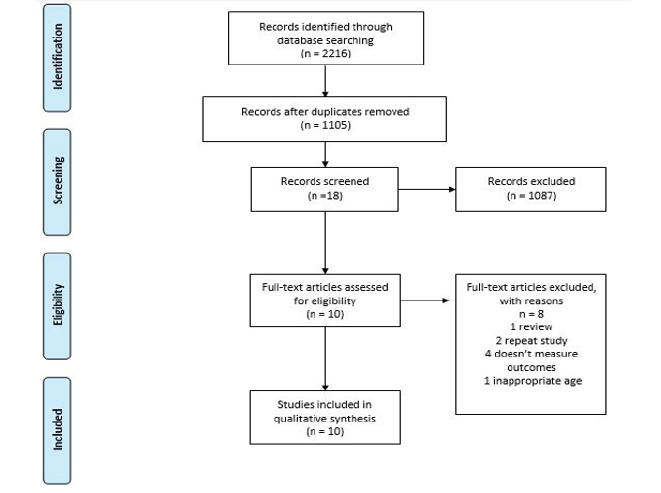

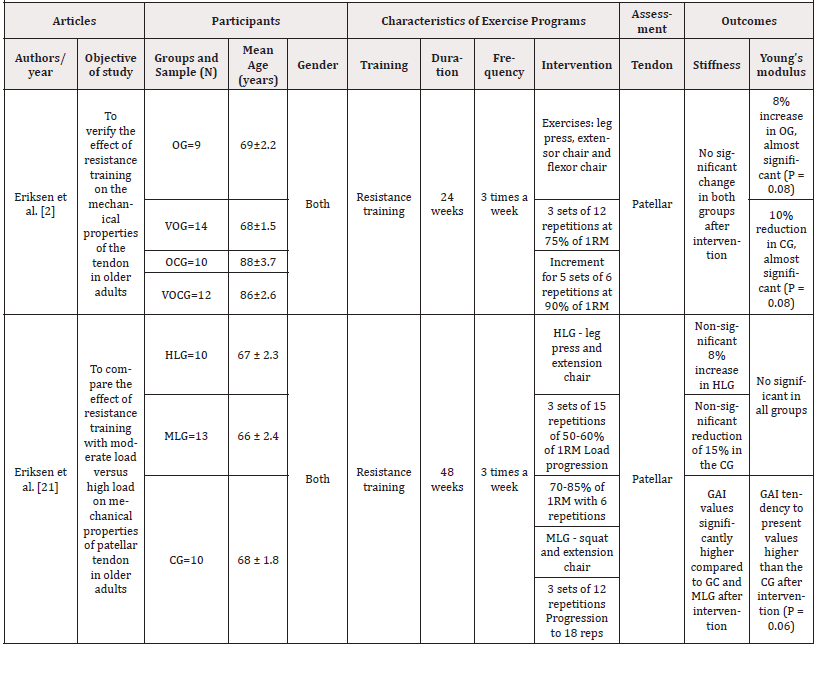
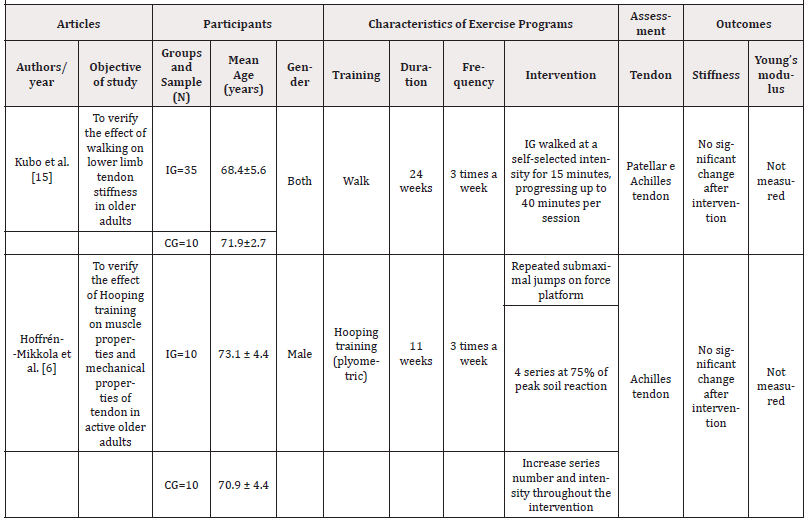
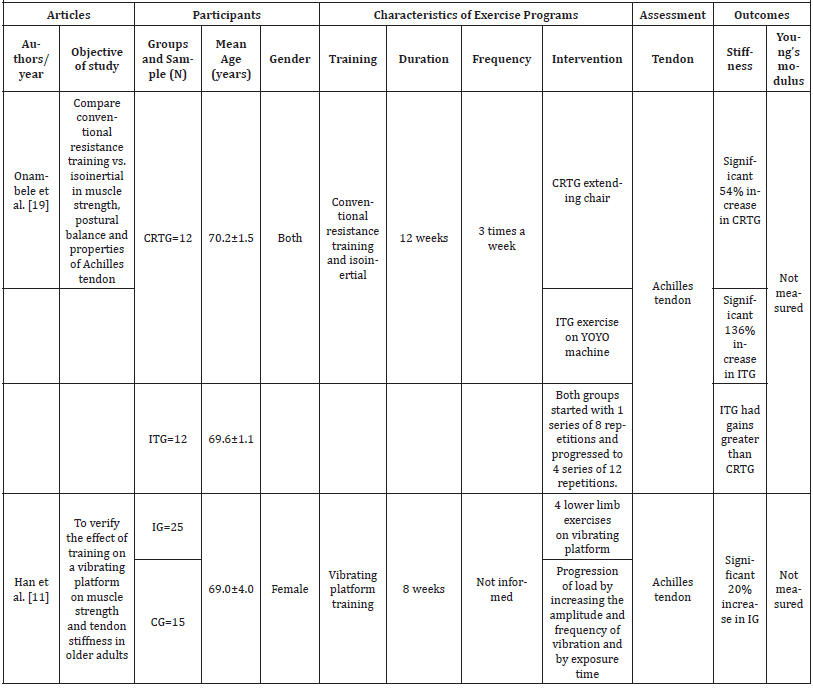
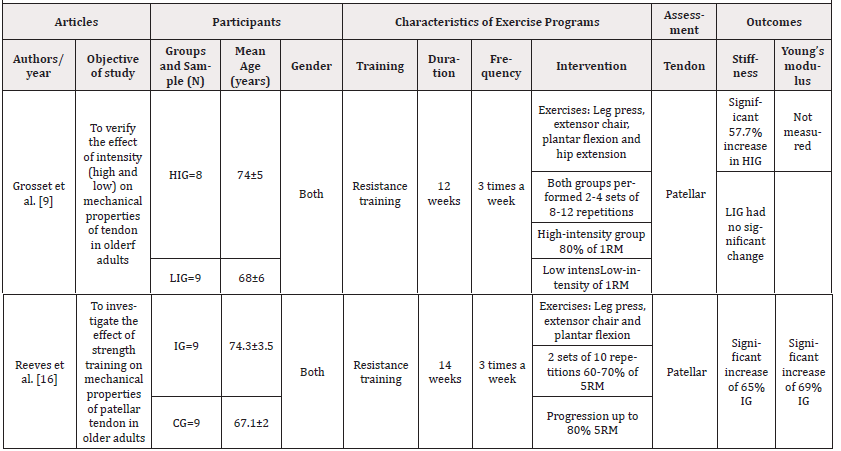



 We use cookies to ensure you get the best experience on our website.
We use cookies to ensure you get the best experience on our website.